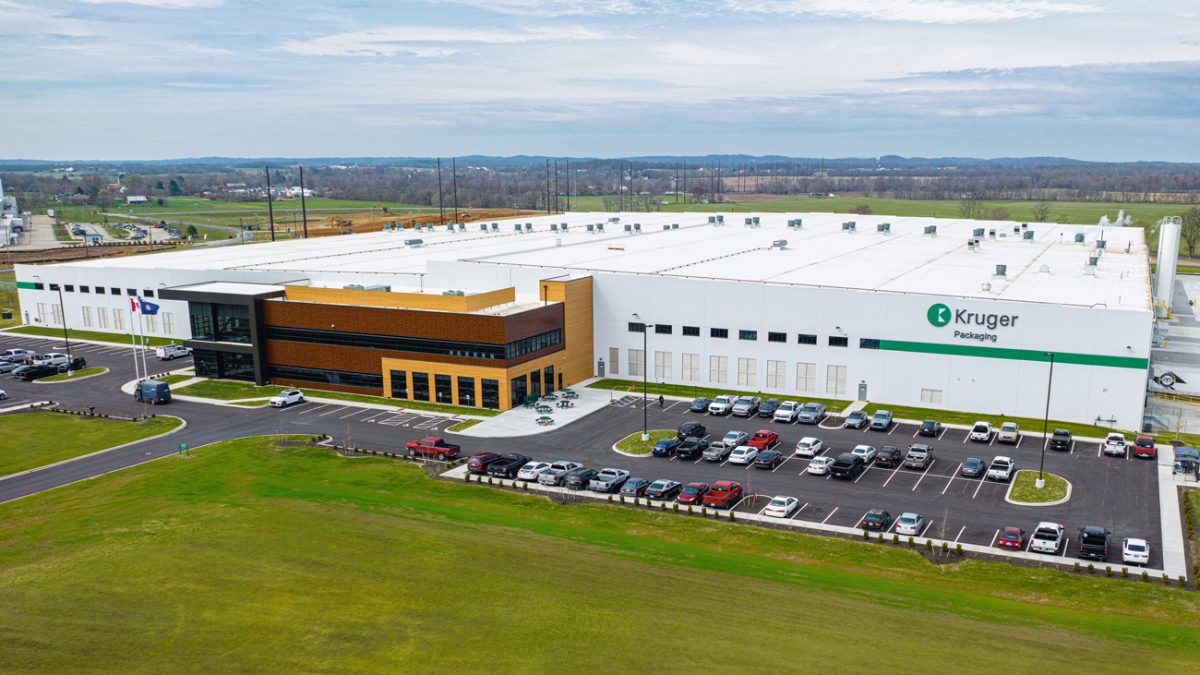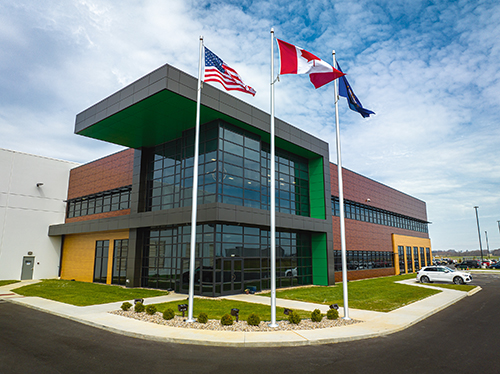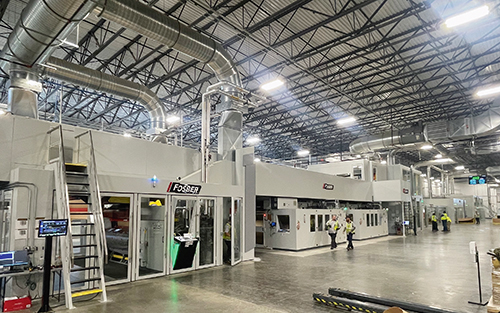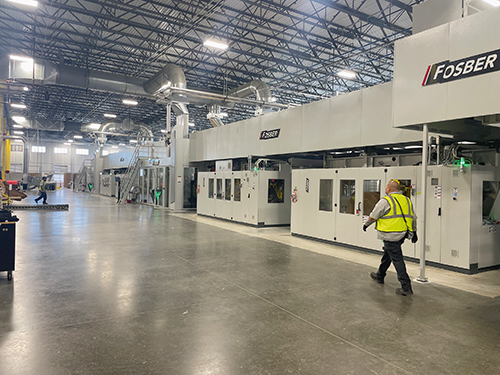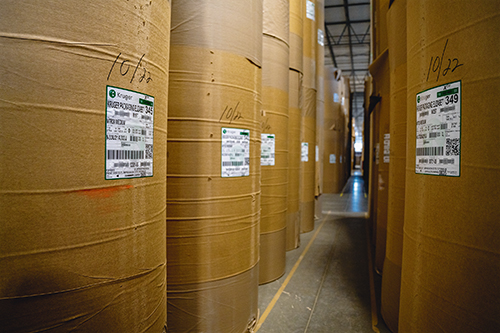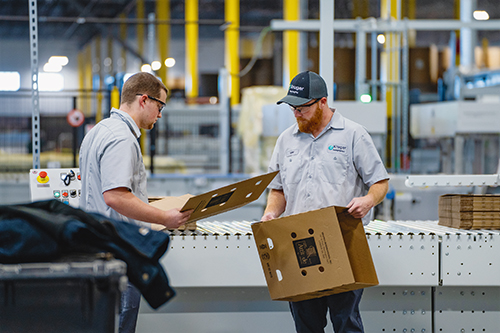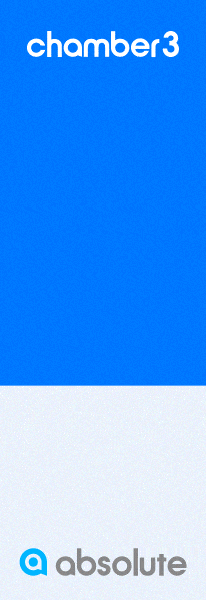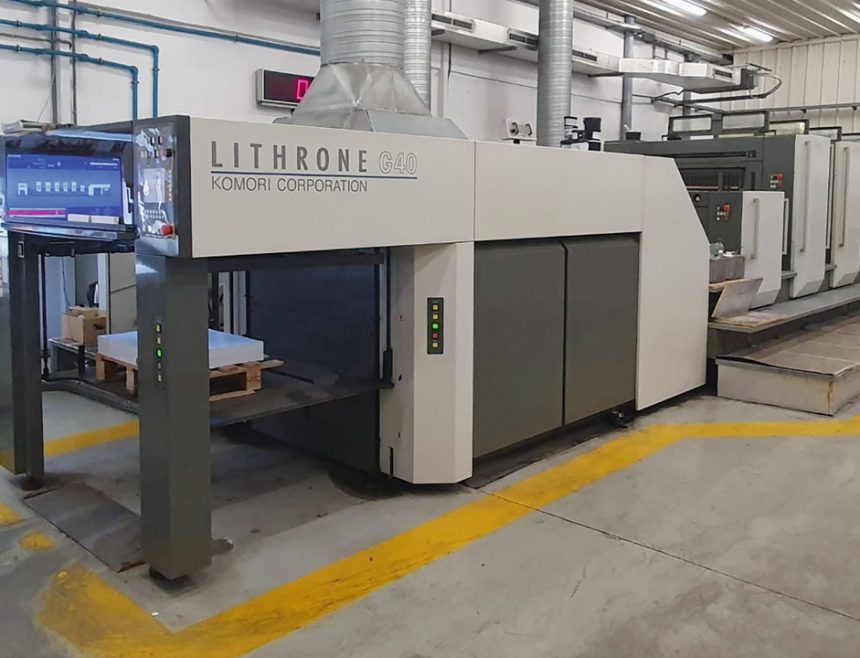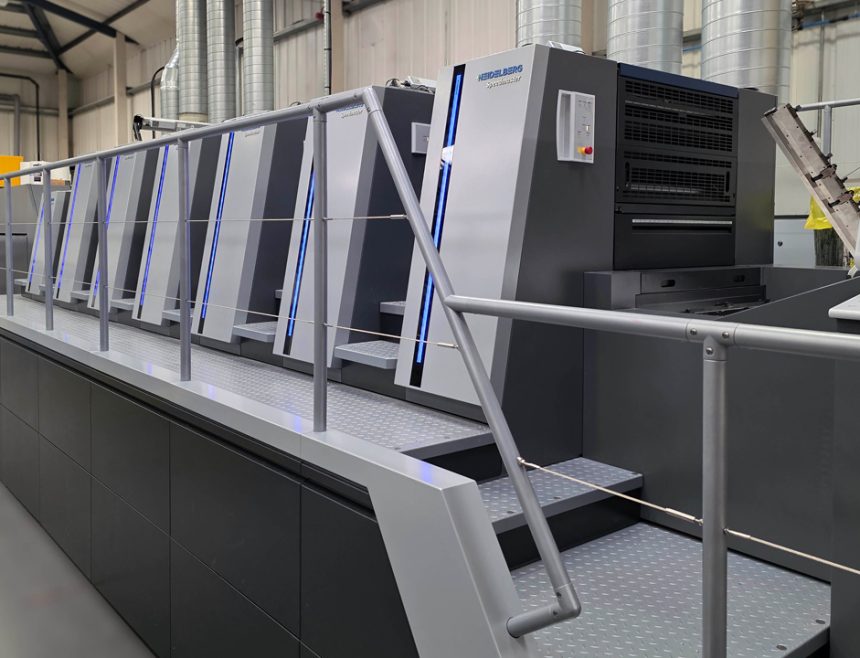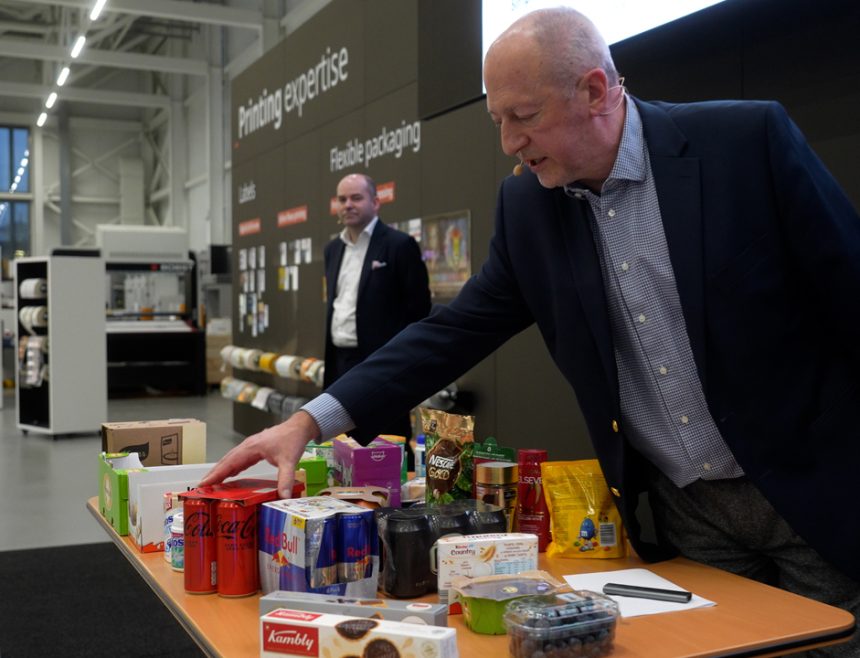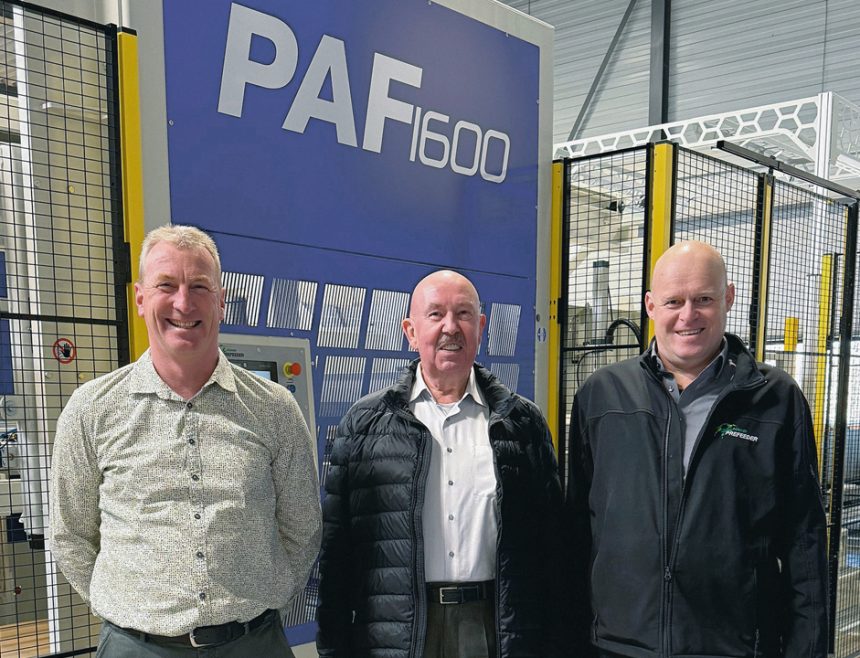Canadian based Kruger, Inc.’s newest corrugated plant is up and running in Elizabethtown, KY. The $142m state-of-the-art packaging facility is considered one of the most advanced in North America with a high level of automation and best in class manufacturing capabilities.
Kruger manufactures 100% recycled containerboard and customized packaging solutions from four facilities in Quebec and Ontario Canada. Since its founding more than 119 years ago, Kruger, a fourth generation family owned company, has embraced a customer centric and market driven focus. “Simply put, it is in the Kruger DNA because it is the most tried tested and true strategy that has enabled us to thrive despite the vagaries of business cycles,” said Michael Lafave, Chief Operating Officer of Kruger Packaging L.P.
The Kentucky packaging plant, Kruger’s first in the U.S., provides significant market expansion beyond the Canadian border. Elizabethtown, known as Etown, is located about 30 miles south of Louisville and within shipping distance to many major US cities. With its modern façade of glass, brick and steel panels, the 500,000 sq ft building is an imposing sight as you drive up to it, resembling a contemporary office complex. The interior is equally impressive with windowed offices, sleek conference and training areas and a large brightly decorated employee break room with a mini-market and an outdoor picnic area.
The temperature-controlled manufacturing area was designed for maximum efficiency. The plant is currently running two shifts with plans to add a third in May. When fully operational, it will employ 150 and produce 2.4 billion sq ft a year of 100% recycled corrugated boxes. By the end of this year, it is projected the plant will have produced 1.4 billion sq ft.
The product mix is largely packaging for the consumer goods markets, including food and beverage and e-commerce. About 50% is pizza boxes.
Lightweight, eco-friendly products are Kruger’s key value propositions to customers. Lafave said, “Our high strength to basis weight properties of the liner and medium we produce from 100% OCC and sorted residential paper offers exceptional performance using lighter weight board combinations than anyone in the North American market and indeed from around the world.”
Latest Generation Machine
At the heart of the new facility is a state-of-the-art Fosber S/Line corrugator. The machine, which is a 2.8m (110″), 460 m/min (1500 fpm) model, can run single and doublewall board. It runs both virgin and recycled liners and medium without problem as well as lighter weight grades.
“We don’t run anything higher than a 30# medium and we run mostly 20# and 26# liners,” said John Keith, General Manager of the Kentucky plant. For doublewall, the corrugator has been running B/E flute as a replacement for 40# and 44# C-flute.
The new corrugator features many of Fosber’s latest generation machine units, including the Link M3 roll/stand splicers for quick and safe roll changes and a double level divert knife for high-speed splice removal. A dedicated starch kitchen from Ringwood ensures correct starch mixture and allows for the minimum amount of glue to be carefully applied via the singlefacer.
Kruger chose the Fosber corrugator for its ability to run lighter weight grades and for its safety features, especially related to the roll handling system. “We don’t use any clamp trucks or industrial equipment near the corrugator on the operator side,” said Keith. “Clamp trucks work on the periphery and deliver rolls to the Harmax roll handling system, which in turn delivers them to the corrugator. From a safety standpoint, Fosber’s Link M3 roll stands are phenomenal.”
Another important aspect of the corrugator when designing the new facility was noise reduction; to this end, full sound enclosures have been fitted to the new S/Line, helping to keep the operating environment clean and quiet.
As with all Fosber lines, the machine at Elizabethtown includes full Syncro corrugator and process control, as well as the Pro/Care package for machine diagnostics and monitoring. To round off the complete offering from Fosber America, a full maintenance plan for OEM quality support is in place. The corrugator uses a steam system from Stickle Steam Specialities, and a Kohler WaterDeck was recently added allowing corrugator operators to quickly change the warp profile on the board while maintaining constant corrugator settings.
All of the paper grades, including Kruger’s signature XTR™ 100% recycled extra high-performance linerboard and corrugating medium and GreenWhite™ white top linerboard, are sourced from Kruger mills in Canada and delivered to Etown via rail car.
The corrugator interfaces with Kiwiplan for scheduling. At plant level, Kruger is running Advantive’s full Kiwiplan order to cash software solution. Within the supply from Advantive, Kruger is also running TSS (Transportation Scheduling Solution) to coordinate shipping and QMS (Quality Management System) on the plant floor. Utilizing the suite of Kiwiplan solutions, coupled with the array of state-of-the-art equipment, this plant is quickly becoming a showcase for how the industry can move toward full automation.
Besides the traditional Kiwiplan scheduling modules, Elizabethtown is also running several automated links to machines that include:
- Rollstock automated link to capture automatic consumption at the wet-end;
- Normal dry-end link;
- Automated Strapper links;
- Automated Conveyor link to WIP;
- In-process automated links to the four converting machines.
Symphony of Processes
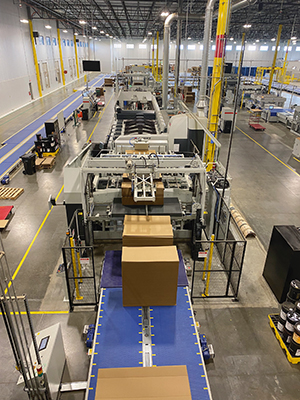 For converting, there are four high-speed BOBST machines: two identical DRO die-cutters, an 8.20 Expertline flexo folder gluer that runs at 24,000 boxes an hour, and a 1228 FFG. All of the machines are four-color with Inkspec viscosity control systems. Both die-cutters have IR dryers from JB Machinery. Where the die-cutters differ is their back end configuration. RDC 1 is a dedicated pizza line. The back end of the machine is a symphony of processes linking together a long and highly automated line consisting of Plexpack shrink tunnels, Bobst bundle breakers, and Mosca bundlers. RDC 2 has half the capacity of RDC 1, with a single pizza line and the capability to run straightline die-cuts.
For converting, there are four high-speed BOBST machines: two identical DRO die-cutters, an 8.20 Expertline flexo folder gluer that runs at 24,000 boxes an hour, and a 1228 FFG. All of the machines are four-color with Inkspec viscosity control systems. Both die-cutters have IR dryers from JB Machinery. Where the die-cutters differ is their back end configuration. RDC 1 is a dedicated pizza line. The back end of the machine is a symphony of processes linking together a long and highly automated line consisting of Plexpack shrink tunnels, Bobst bundle breakers, and Mosca bundlers. RDC 2 has half the capacity of RDC 1, with a single pizza line and the capability to run straightline die-cuts.
“No one has ever had these DROs with these kind of back ends. It’s really something,” said Keith. “It’s almost like working on a corrugator.”
A fifth bay is available for an additional Bobst machine, make and model to be decided.
Rotary dies, printing plates and ink buckets are stored on a mezzanine above the manufacturing area serviced by an elevator for automatic transport to the converting lines. Dies are kept on a BCM Transtech semi-automatic storage rack system. Inks are supplied by Quantum Ink Co.
Material transport is fully automated from the corrugator to finished goods and integrates a vertical WIP warehouse from WSA-USA. WSA’s scope of supply included:
- Fully automatic material handling system including a Vertical WIP Storage and iFAS Smart Factory Automation System. The four level rack system is located between the corrugator and converting and has a footprint of approximately 15,000 sq ft. It includes 288 cells and is serviced by two Korber stacker cranes. It can store approximately 8 million sq ft of in-process product.
- Automatic Tooling Delivery and Retrieval System from the converting machine centers to the mezzanine.
- Automatic Roll Delivery and Butt Roll return system from the roll storage room to the Fosber corrugator.
Finished sheets off the corrugator go directly into the WIP warehouse or downstream to converting or to shipping where they are strapped and prepared for delivery to local sheet plants. Etown has two shipping lines with load doublers, pallet inserters, tiering devices and EAM Mosca unitizers and palletizers. The plant has 27 dock doors.
Culture of Collaboration
John Keith has more than 35 years of experience in the corrugated industry working for both integrated and independent companies. The Etown plant was his sixth greenfield startup. He said these types of projects are “huge events, like bringing a small city together.”
To ensure everything went smoothly on the machine side, Kruger took the unusual approach of tasking the main suppliers, such as Fosber, Bobst and WSA, with selecting and managing the ancillary components from other companies. Keith and his team met with the OEMs twice a day as a group to talk about the schedule and startup. He attributes this team approach to fostering collaboration and laying the groundwork for a culture of excellence that is reflected throughout the facility.
Keith said staffing the plant posed few challenges. Eighty percent of the salaried staff was in place by November 2021, before any of the machines had started up. The managers have more than 400 years of combined corrugated experience.
For hourly employees, Kruger participated in local job fairs and posted announcements on social media platforms, such as LinkedIn and Facebook. “At the first job fair, I interviewed 37 people in four hours,” said Keith. “We still have a huge pool of people we haven’t even called on yet. We’re getting ready to go to a third shift so every two weeks we’re starting another five to eight people, putting them through intensive classroom training and then hands-on training on the machines.”
The startup of the Etown plant has been particularly gratifying for Keith. He is especially proud of the workforce who he says are committed to the plant’s success. Indeed, walking about the manufacturing floor, it is clear that they enjoy working there. “We’re all really blessed to be here. It’s a great plant to work,” said Blake Watson, Corrugator Supervisor. Watson had worked at another box plant before joining Kruger a year and a half ago. When asked how this plant is different, he said, “For one, safety is of the utmost importance here. Knowing that all of our employees will go home the same way they came in is what separates us; that, and the state-of-the-art machinery to meet our customer’s timelines and to give them the best product possible.”

